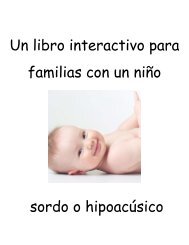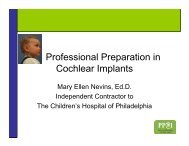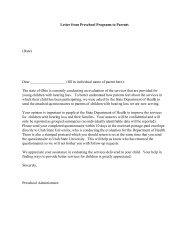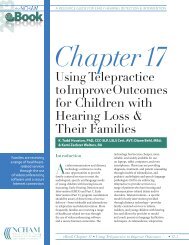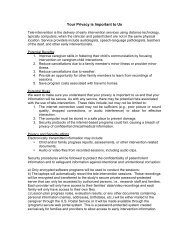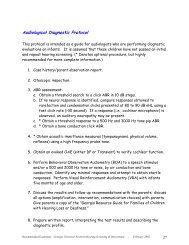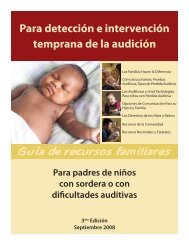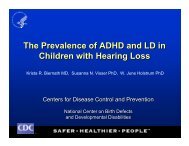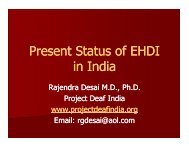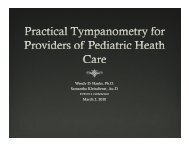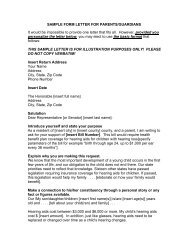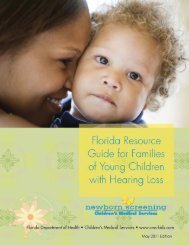Title: Assessment of State Early Hearing, and Intervention Programs ...
Title: Assessment of State Early Hearing, and Intervention Programs ...
Title: Assessment of State Early Hearing, and Intervention Programs ...
Create successful ePaper yourself
Turn your PDF publications into a flip-book with our unique Google optimized e-Paper software.
2007 EHDI Conference – Salt Lake City, UT Topical Session 3<br />
Last Updated: 03/13/07<br />
Room: Alta<br />
<strong>Title</strong>: <strong>Assessment</strong> <strong>of</strong> <strong>State</strong> <strong>Early</strong> <strong>Hearing</strong>, <strong>and</strong> <strong>Intervention</strong> <strong>Programs</strong> (EHDI): A<br />
Program Operations Evaluation Protocol (RTI)<br />
Author(s): Pam Costa, Lucia Rojas-Smith<br />
Affiliation(s): Centers for Disease Control <strong>and</strong> Prevention, National Center on Birth<br />
Defects <strong>and</strong> Developmental Disability, <strong>Early</strong> <strong>Hearing</strong> Detection <strong>and</strong> <strong>Intervention</strong><br />
Presented by: Pam Costa, Lucia Rojas-Smith<br />
Abstract:<br />
Keywords:
2007 EHDI Conference – Salt Lake City, UT Topical Session 3<br />
Last Updated: 03/13/07<br />
Room: Brighton<br />
<strong>Title</strong>: Newborn <strong>Hearing</strong> Screening Training Module<br />
Author(s): R<strong>and</strong>i Winston, Au.D. 1,2, Lylis Olsen, MS, MPH 2, Karen Ditty, Au.D. 2,<br />
Terry Foust, Au.D. 2, Diane Sabo, Ph.D. 2, Marlene Hesley 3, LPN, Karen Munoz,<br />
Ed.D. 2<br />
Affiliation(s): 1 The EAR Foundation <strong>of</strong> Arizona, Phoenix, AZ , 2 The National Center<br />
for <strong>Hearing</strong> <strong>Assessment</strong> <strong>and</strong> Management, Utah <strong>State</strong> University, 3 Banner Desert<br />
Hospital<br />
Presented by: R<strong>and</strong>i Winston, Lylis Olsen<br />
Abstract: Although hospital based universal newborn hearing screening programs have<br />
been implemented in the majority <strong>of</strong> hospitals in the country, state EHDI programs <strong>and</strong><br />
hospitals face the ongoing challenge <strong>of</strong> ensuring that all screening staff are properly<br />
trained <strong>and</strong> competent. Inadequately trained screening staff jeopardizes the integrity<br />
<strong>and</strong> efficiency <strong>of</strong> the early identification process. The EAR Foundation <strong>of</strong> Arizona in<br />
collaboration with NCHAM has developed a competency based training module to meet<br />
hospital’s training needs that will provide a consistent <strong>and</strong> comprehensive training<br />
solution to the high rate <strong>of</strong> turnover <strong>and</strong> the need for ongoing quality assurance.<br />
Development <strong>of</strong> st<strong>and</strong>ardized materials that can be applied to diverse hospital settings<br />
is an important goal. This session will demonstrate the newly developed, multi-media<br />
training module.<br />
Keywords: universal newborn hearing screening programs, competency based training<br />
curriculum, ongoing quality assurance
2007 EHDI Conference – Salt Lake City, UT Topical Session 3<br />
Last Updated: 03/13/07 Room: Deer Valley #1<br />
<strong>Title</strong>: False Positive Inpatient Screening <strong>and</strong> Parental Anxiety<br />
Author(s): Linda D. Goetze 1, Renata Vintila-Hardwick 1, Karl R. White 2, Scott Grosse<br />
3<br />
Affiliation(s): 1 <strong>Early</strong> <strong>Intervention</strong> Research Institute, Utah <strong>State</strong> University, 2 National<br />
Center for <strong>Hearing</strong> <strong>Assessment</strong> <strong>and</strong> Management, 3 Centers for Disease Control<br />
Presented by: Linda Goetze<br />
Abstract: Objective: We address concerns raised about the impacts <strong>of</strong> false positive<br />
results <strong>of</strong> infant hearing screening tests on families.<br />
Relevance: We have conducted surveys <strong>of</strong> families <strong>of</strong> infants in Utah who were referred<br />
from newborn hearing screening for further testing over three years. Three samples <strong>of</strong><br />
families were recruited based on whether the infant was referred to <strong>and</strong> passed an<br />
outpatient screen (n = 117), was referred from outpatient screening to diagnostic testing<br />
<strong>and</strong> was either passed (n = 110) or was diagnosed with hearing loss (n = 152). This<br />
allows us to examine whether there is lingering anxiety after a baby does not pass<br />
inpatient screening tests.<br />
Implications for Policy or Practice: Generally, families in all groups felt moderately<br />
supported by hospital staff. Moderate anxiety following the completion <strong>of</strong> screening was<br />
reported by the families in both groups who were referred to diagnostic testing. In<br />
comparison, a very low level <strong>of</strong> anxiety was reported by families who were referred to<br />
outpatient testing but whose infants passed. Finally, all groups expressed strong<br />
agreement that they were glad that hearing screening had been performed. The<br />
findings by screening group suggest that families whose babies have false positive<br />
screening results while in the hospital have very little lingering anxiety or dissatisfaction<br />
as a result <strong>of</strong> the outpatient screening test that follows.<br />
Summary: This study indicates a high level <strong>of</strong> parent satisfaction with newborn hearing<br />
screening among families whose children had false positive inpatient screening tests.<br />
The most anxiety about the screening process was expressed by families whose babies<br />
were ultimately diagnosed with a hearing loss. The results suggest that the affect <strong>of</strong> an<br />
inpatient false positive hearing screening result on later parent anxiety <strong>and</strong> satisfaction<br />
is minimal.<br />
Keywords: Parent satisfaction <strong>and</strong> anxiety, Effects <strong>of</strong> false positive screening
2007 EHDI Conference – Salt Lake City, UT Topical Session 3<br />
Last Updated: 03/13/07 Room: Deer Valley #2<br />
<strong>Title</strong>: Family Conversations: Giving a Jump on Language <strong>and</strong> Literacy<br />
Author(s): Ann Curry M.Ed., Susan Norton PhD.<br />
Affiliation(s): Children’s Hospital & Regional Medical Center<br />
Presented by: Ann Curry, Susan Norton<br />
Abstract: Following confirmation <strong>of</strong> their baby’s hearing loss parents are faced with<br />
many challenges including selecting an early intervention program. Too <strong>of</strong>ten different<br />
communication methodologies (e.g. ASL, Auditory Oral, <strong>and</strong> Total Communication) are<br />
presented to families as distinct <strong>and</strong> separate options. However, each child with hearing<br />
loss <strong>and</strong> their family has a unique set <strong>of</strong> strengths <strong>and</strong> needs. This presentation will<br />
describe Family Conversations <strong>Early</strong> <strong>Intervention</strong> Program for Infants with <strong>Hearing</strong> Loss<br />
<strong>and</strong> their Families. This program provides opportunities for families to find the<br />
combination <strong>of</strong> techniques that works best for their child <strong>and</strong> family. Both visual <strong>and</strong><br />
auditory means are used to establish clear communication between families <strong>and</strong> their<br />
child <strong>and</strong> to help the child underst<strong>and</strong> <strong>and</strong> use the primary language <strong>of</strong> the home.<br />
Instruction is designed to enhance the parent-child relationship <strong>and</strong> include all family<br />
members, as well as support the incorporation <strong>of</strong> new strategies into everyday life so<br />
parents can provide the love <strong>and</strong> nurturing necessary to raise a child in today’s society.<br />
Home visits, playgroup, parent support/education, a lending library, sign language<br />
instruction, Deaf community/cultural events, literacy kits, <strong>and</strong> transition services are all<br />
provided as part <strong>of</strong> this program. Visual means <strong>of</strong> communication (gestures, lip reading,<br />
sign language, <strong>and</strong>/or cued speech) are combined with speech to help children develop<br />
their language, speech <strong>and</strong> listening skills. Use <strong>of</strong> hearing aids, FM systems, <strong>and</strong>/or<br />
cochlear implants to learn to underst<strong>and</strong> <strong>and</strong> use spoken language is strongly<br />
supported. Families learn to include their child in all family conversations. An emphasis<br />
is placed on literacy through materials, modeling, exploration <strong>and</strong> play. Summary data<br />
as well as video examples <strong>of</strong> individual sessions will be presented. This presentation<br />
will help those seeking to provide unbiased information <strong>and</strong> early intervention services<br />
for deaf <strong>and</strong> hard <strong>of</strong> hearing infants <strong>and</strong> their families.<br />
Keywords: <strong>Early</strong> <strong>Intervention</strong>, Language, Literacy
2007 EHDI Conference – Salt Lake City, UT Topical Session 3<br />
Last Updated: 03/13/07 Room: Deer Valley #3<br />
<strong>Title</strong>: Outreach to Physicians with Delta Zeta Project<br />
Author(s): Sondra King, Penny Baker, Constance Block, Susan Wiley<br />
Affiliation(s): Family Advisor, Ohio Universal Newborn <strong>Hearing</strong> Screening Advisory<br />
Committee, Ohio Coordinator for Delta Zeta Sound Beginnings Project, EHDI Project<br />
Director, Ohio Department <strong>of</strong> Health, Ohio AAP Chapter Champion, Cincinnati<br />
Children’s Hospital Medical Center<br />
Presented by: Constance Block, Sondra King<br />
Abstract: Objective: This presentation will provide a collaborative model for<br />
dissemination <strong>of</strong> information to physicians.<br />
NCHAM developed a community outreach program with a national social sorority, Delta<br />
Zeta. Although the initial national project linked Delta Zeta college students with WIC<br />
programs, the Ohio Department <strong>of</strong> Health <strong>and</strong> the Ohio Delta Zeta chapters<br />
collaborated to extend this educational outreach effort to target physicians.<br />
This presentation will discuss the needed preparation <strong>and</strong> training activities for the<br />
sororities, barriers <strong>and</strong> successes for information dissemination to physicians, <strong>and</strong><br />
general feedback from the sororities about their experiences in using this model for<br />
physician education.<br />
As states continue to identify effective methods <strong>of</strong> physician education, this project may<br />
be one strategy among many to disseminate information on universal newborn hearing<br />
screening <strong>and</strong> the importance <strong>of</strong> follow-up for children who do not pass their newborn<br />
hearing screens.<br />
Using multiple strategies for physician <strong>and</strong> public awareness regarding the importance<br />
<strong>of</strong> UNHS <strong>and</strong> follow-up care is important for the success <strong>of</strong> EHDI. Collaborating with<br />
community groups, such as philanthropic sororities may provide a low cost strategy.<br />
Keywords: Educational Outreach to Physicians, Community Collaboration
2007 EHDI Conference – Salt Lake City, UT Topical Session 3<br />
Last Updated: 03/13/07<br />
Room: Park City<br />
<strong>Title</strong>: On The Road Again: How Site Visits Can Improve EHDI <strong>Programs</strong><br />
Author(s): Lorie J. Lang, M.A. CCC-A, Debra Behringer, M.S., RN<br />
Affiliation(s): Michigan Department <strong>of</strong> Community Health EHDI Program<br />
Presented by: Lorie Lang<br />
Abstract: Over the past 11/2 years, all Michigan birthing hospitals have received a visit<br />
from an EHDI staff member in collaboration with the metabolic program. Site visits have<br />
provided an opportunity for increasing communication between the hospital <strong>and</strong> the<br />
EHDI program to facilitate dissemination <strong>of</strong> information regarding state guidelines,<br />
protocol for screening <strong>and</strong> m<strong>and</strong>atory reporting. In addition, pediatric audiology site<br />
visits began in the summer <strong>of</strong> 2006. More in depth review <strong>of</strong> diagnostic protocols/<br />
equipment are discussed at these visits as well as introductions <strong>of</strong> local area parents<br />
who serve as parent guides in Michigan’s Guide-By-Your Side Program. By putting a<br />
name to a face, progress is being made in reporting <strong>and</strong> referrals! Site visit tool for both<br />
facility visits will be shared.<br />
Keywords: Site Visit Tool
2007 EHDI Conference – Salt Lake City, UT Topical Session 3<br />
Last Updated: 03/13/07<br />
Room: Snowbird<br />
<strong>Title</strong>: Is <strong>Early</strong> <strong>Intervention</strong> Necessary for All?<br />
Author(s): Mary Jane Sullivan AuD CCC-A 1, 2, Ruth Fox RN, MS 2, Jan Halley OTR<br />
3<br />
Affiliation(s): 1 University <strong>of</strong> New Hampshire, 2 New Hampshire EHDI Program, 3 N.H.<br />
Multi-Sensory through Consultation <strong>and</strong> Education (MICE) Program<br />
Presented by: Mary Sullivan, Ruth Fox<br />
Abstract: The Joint Committee on Infant <strong>Hearing</strong> (JCIH) goal <strong>of</strong> providing early<br />
intervention services for all infants identified with hearing loss by 6 months <strong>of</strong> age is<br />
widely supported. The question we plan to address is:<br />
Do all babies with hearing loss, regardless <strong>of</strong> the degree <strong>and</strong> type, require direct<br />
intervention services? Historically, in New Hampshire, all children between birth <strong>and</strong> 3<br />
years <strong>of</strong> age with a diagnosed hearing loss were automatically enrolled in early<br />
intervention services. This process continues for many children, however, universal<br />
newborn hearing screening has increased the program dem<strong>and</strong>s due to the<br />
identification <strong>of</strong> children with milder forms <strong>of</strong> hearing loss. Given this, adjustments <strong>of</strong> the<br />
traditional service model were necessary. We will present the criteria used to<br />
developed New Hampshire’s modified early intervention service plan designed for<br />
infants with milder degrees <strong>of</strong> hearing loss. The changes in our traditional early<br />
intervention model are based on each child’s audiological results <strong>and</strong> parental requests.<br />
We will address the factors which influenced these changes including parental<br />
responses <strong>and</strong> personnel limitations. Additionally, the process <strong>of</strong> including the<br />
diagnosing audiologists in the intervention planning will be discussed.<br />
Keywords: Parental Input, Pr<strong>of</strong>essional Collaboration
2007 EHDI Conference – Salt Lake City, UT Topical Session 3<br />
Last Updated: 03/13/07<br />
Room: Solitude<br />
<strong>Title</strong>: What is Audism<br />
Author(s): Beth Benedict, Ph.D. 1,2, Barbara Raimondo, J.D. 2<br />
Affiliation(s): 1 Gallaudet University, 2 American Society for Deaf Children<br />
Presented by: Barbara Raimondo <strong>and</strong> Beth Benedict<br />
Abstract: Most individuals are not familiar with the term “audism,” which is just coming<br />
into popular use. The definition <strong>of</strong> audism will be introduced, <strong>and</strong> a clip <strong>of</strong> the<br />
forthcoming movie, “Audism Unveiled,” will be shown. In this film deaf adults convey<br />
their experiences with communication throughout their lives. An audience discussion will<br />
follow.<br />
What is audism? How does it impact the family <strong>and</strong> educational life <strong>of</strong> a deaf or hard <strong>of</strong><br />
hearing child? What should pr<strong>of</strong>essionals know about audism?<br />
Be prepared to have a frank <strong>and</strong> open discussion about this controversial topic.<br />
Keywords: Audism, families, pr<strong>of</strong>essionals, deaf community



